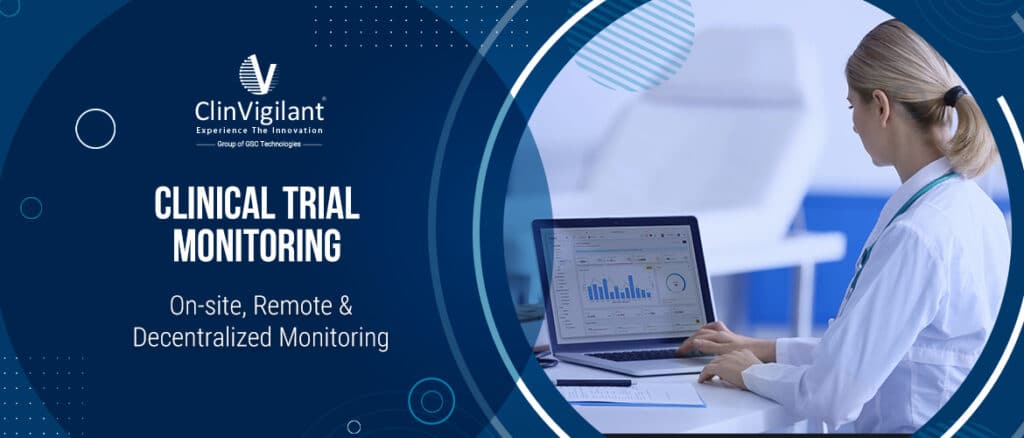Clinical trial monitoring is a critical aspect of clinical research monitor, ensuring the safety of participants and the integrity of data collected. There are three primary methods of clinical trial monitoring: on-site monitoring, remote monitoring, and centralized monitoring

On-site monitoring involves in-person evaluations performed by staff or representatives of the sponsor at the investigation site. This traditional method allows for direct oversight of trial processes, including the ability to monitor site productivity, identify bottlenecks, and assess the performance of new sites based on past performance. However, on-site monitoring can be resource-intensive and may be limited by factors such as geographical distance or public health crises like the COVID-19 pandemic.
Remote monitoring in clinical trials, on the other hand, allows for oversight of clinical trials without the need for physical presence at the investigation site. This method has been particularly useful during the COVID-19 pandemic, when access to investigation sites was limited. Remote monitoring can include virtual, hybrid, and decentralized clinical trials. While this method can increase efficiency and reduce costs, it also raises concerns about patient-investigator relationships, advanced regulatory requirements, and patient safety and security.
Centralized monitoring is another method that uses a centralized system to oversee multiple trial sites. This approach can reduce the costs of on-site visits and allows sponsors to target on-site monitoring for higher-risk clinical studies. However, it may require increased budgeting for programming and analysis.
All three methods can be used in combination for effective oversight, monitoring, and protection of data integrity and patient safety. The choice of monitoring method depends on various factors, including the objective, purpose, design, complexity, size, and endpoints of the trial
On-site Monitoring
On-site monitoring involves sponsors sending monitors to all or select research sites to perform source data verification and ensure compliance with protocol, good clinical practice (GCP), and applicable regulations. This traditionally has been the standard approach for sponsors to oversee trials.
The Benefits of On-site Monitoring
- Allows direct verification of records against source documents
- Builds relationships between sponsor and study site
- Provides real-time issue identification and resolution
- Gives monitors direct observations of site processes and infrastructure
However, full on-site monitoring is extremely time- and cost-intensive, leading sponsors to shift to alternative monitoring approaches.
Remote Monitoring
Remote clinical monitoring allows off-site personnel to review data and processes without traveling to study sites. This often involves sites uploading source documents, data, recordings, and other files to a sponsor portal for review.
The Benefits of Remote Monitoring
- Reduces monitor travel time and expenses
- Provides flexible scheduling for sites around patient visits
- Enables review of many processes without site visits
- Allows centralization of monitoring expertise and workload distribution
However, remote monitoring lacks on-site verification and interactions. Many sponsors now use a hybrid approach to maximize efficiency.
Centralized Monitoring
Centralized monitoring focuses review on critical data and processes to identify risks and trends across sites and studies. This allows identification of systemic issues for risk-based monitoring in clinical trials site selection and monitoring plans.
The Benefits of Centralized Monitoring
- Concentrates oversight on key risk indicators
- Detects issues across sites to enable targeted mitigation
- Informs selective site monitoring to maximize efficiency
- Continual process facilitates adaptation of monitoring plans
- Analytics enable metrics-based performance tracking
This focused approach may miss site-specific issues. Centralized monitoring often supplements other methods.
Virtual Clinical Trials
Virtual clinical trials deliver investigative interventions remotely and leverage technology to enable decentralized participation. Patients engage using their own devices without traveling to study sites.
The Benefits of Virtual Clinical Trials
- Increases accessibility for patients unable or unwilling to attend physical sites
- Enables enrollment and retention of more diverse, representative participants
- Reduces overall study costs
- Allows for scalability to recruit participants quickly
- Facilitates use of advanced analytics and centralized monitoring
However, lack of in-person oversight presents regulatory, privacy, and data quality concerns. Oversight processes must adapt accordingly.
Decentralized Clinical Trials
Decentralized clinical trials distribute aspects of studies across multiple stakeholder settings and locations. Activities like enrollment, interventions, assessments, and monitoring may occur outside of research sites through coordination of various healthcare access points closer to patients.
The Benefits of Decentralized Clinical Trials
- Improves convenience and accessibility for patients
- Accelerates participant recruitment and retention
- Reduces number of site contracts and management
- Decreases travel costs for both subjects and monitors
- Enables more flexible, patient-centric designs
- Allows for simplified integration of virtual solutions
However, decentralization presents data, supply, and oversight coordination challenges across the multiple participating entities and systems.
Hybrid Clinical Trials
Many sponsors now utilize a hybrid approach that combines elements of the above methods to maximize efficiency. Hybrid models aim to redistribute clinical trial oversight, facilitating both centralization for scalability and targeted on-site verification for quality assurance.
The Benefits of Hybrid Clinical Trials
- Balances workload across centralized, remote, and on-site personnel
- Concentrates expertise for large-scale data analytics
- Informs risk-based site selection and face-to-face monitoring
- Retains focused site interactions to strengthen partnerships
- Enables scalability required for urgent needs like pandemic response
- Allows for flexibility to adapt model to evolving best practices
Careful calibration is necessary to realize these blended potential benefits while minimizing coordination complexity. But properly designed hybrid oversight can concurrently improve quality, accelerate trials, expand access and diversity, and reduce costs.
Conclusion
Technology is enabling transformation of traditional site-centric oversight toward more centralized, risk-based, and virtual solutions. Meanwhile patient-centricity is driving further distribution of research through decentralized clinical trials. Most sponsors now use hybrid monitoring models balancing various methods to enhance quality, efficiency, and oversight scalability. Through reimagined risk mitigation and leverage of burgeoning tools, the clinical trials enterprise can usher in a new era advancing research and improving human health globally.
FAQs
What are the main types of clinical trial monitoring?
The main monitoring methods are on-site, remote, centralized, and hybrid approaches. Many trials also now incorporate virtual and decentralized elements.
What is centralized monitoring and what are its benefits?
Centralized monitoring analyzes data across sites to identify risks and systemic issues to inform targeted site selection and monitoring. Benefits include efficiency, risk detection, and flexibility.
How is a hybrid clinical trial different from a traditional trial?
Hybrid trials strategically combine risk-based centralized oversight, off-site remote monitoring leveraging technology, and on-site verification for quality assurance and partnerships. This balances workload and oversight scalability.
What has driven advancement of clinical monitoring approaches?
Need for improved quality, operational efficiency, oversight scalability, patient diversity, and modernization through new technologies has led evolution beyond full on-site monitoring.
Do You Know Which Type Of Monitoring Suits Best For Your Clinical Trial?
Do you need our support in your clinical development or are you looking for any of our services for your clinical trials? Provide your requirement details below to connect with us and explore our expertise.

